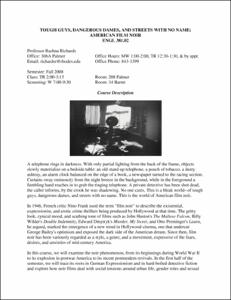Please use this identifier to cite or link to this item:
http://hdl.handle.net/10267/3462Full metadata record
| DC Field | Value | Language |
|---|---|---|
| dc.contributor.author | Richards, Rashna | - |
| dc.date.accessioned | 2009-02-19T18:20:12Z | - |
| dc.date.available | 2009-02-19T18:20:12Z | - |
| dc.date.issued | 2008-08-27 | - |
| dc.identifier.uri | http://hdl.handle.net/10267/3462 | - |
| dc.description | This syllabus was submitted to the Office of Academic Affairs by the course instructor. | en_US |
| dc.description.abstract | A telephone rings in darkness. With only partial lighting from the back of the frame, objects slowly materialize on a bedside table: an old stand-up telephone, a pouch of tobacco, a dusty ashtray, an alarm clock balanced on the edge of a book, a newspaper turned to the racing section. Curtains sway ominously from the night breeze in the background, while in the foreground a fumbling hand reaches in to grab the ringing telephone. A private detective has been shot dead, the caller informs, by the crook he was shadowing. No one cares. This is a bleak world--of tough guys, dangerous dames, and streets with no name. This is the world of American film noir. In 1946, French critic Nino Frank used the term "film noir" to describe the existential, expressionist, and erotic crime thrillers being produced by Hollywood at that time. The gritty look, cynical mood, and scathing tone of films such as John Huston's The Maltese Falcon, Billy Wilder's Double Indemnity, Edward Dmytryk's Murder, My Sweet, and Otto Preminger's Laura, he argued, marked the emergence of a new trend in Hollywood cinema, one that undercut George Bailey's optimism and exposed the dark side of the American dream. Since then, film noir has been variously regarded as a style, a genre, and a movement, expressive of the fears, desires, and anxieties of mid-century America. In this course, we will examine the noir phenomenon, from its beginnings during World War II to its explosion in postwar America to its recent postmodern revivals. In the first half of the semester, we will trace its roots in German Expressionism and in hard-boiled detective fiction and explore how noir films deal with social tensions around urban life, gender roles and sexual identities, race relations, and so on while complicating the success story of postwar America. During the second half, we will consider why the bleakness and disillusionment pervasive during World War II continue to resonate in American cinema and analyze how neo-noir films both honor and parody classic noir. | en_US |
| dc.language.iso | en_US | en_US |
| dc.publisher | Memphis, Tenn. : Rhodes College | en_US |
| dc.relation.ispartofseries | Syllabi CRN | - |
| dc.relation.ispartofseries | 19500 | - |
| dc.rights | Rhodes College owns the rights to the digital objects in this collection. Objects are made available for educational use only and may not be used for any non-educational or commercial purpose. Approved educational uses include private research and scholarship, teaching, and student projects. For additional information please contact archives@rhodes.edu. Fees may apply. | - |
| dc.subject | English, Department of | en_US |
| dc.subject | Syllabus | en_US |
| dc.subject | Curriculum | en_US |
| dc.subject | Academic departments | en_US |
| dc.subject | Text | en_US |
| dc.subject | 2008 Fall | en_US |
| dc.title | ENGL 381-01, Tough Guys, Dangerous Dames, and Streets With No Name: American Film Noir, Fall 2008 | en_US |
| dc.type | Syllabus | en_US |
| Appears in Collections: | Course Syllabi | |
Files in This Item:
| File | Description | Size | Format | |
|---|---|---|---|---|
| 2008_fall_ENGL_381_02_19500.pdf | 59.24 kB | Adobe PDF |  View/Open |
Items in DSpace are protected by copyright, with all rights reserved, unless otherwise indicated.